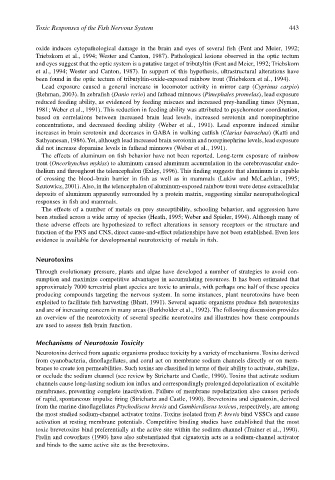Page 463 - The Toxicology of Fishes
P. 463
Toxic Responses of the Fish Nervous System 443
oxide induces cytopathological damage in the brain and eyes of several fish (Fent and Meier, 1992;
Triebskorn et al., 1994; Wester and Canton, 1987). Pathological lesions observed in the optic tectum
and eyes suggest that the optic system is a putative target of tributyltin (Fent and Meier, 1992; Triebskorn
et al., 1994; Wester and Canton, 1987). In support of this hypothesis, ultrastructural alterations have
been found in the optic tectum of tributyltin-oxide-exposed rainbow trout (Triebskorn et al., 1994).
Lead exposure caused a general increase in locomotor activity in mirror carp (Cyprinus carpio)
(Rehman, 2003). In zebrafish (Danio rerio) and fathead minnows (Pimephales promelas), lead exposure
reduced feeding ability, as evidenced by feeding miscues and increased prey-handling times (Nyman,
1981; Weber et al., 1991). This reduction in feeding ability was attributed to psychomotor coordination,
based on correlations between increased brain lead levels, increased serotonin and norepinephrine
concentrations, and decreased feeding ability (Weber et al., 1991). Lead exposure induced similar
increases in brain serotonin and decreases in GABA in walking catfish (Clarias batrachus) (Katti and
Sathyanesan, 1986). Yet, although lead increased brain serotonin and norepinephrine levels, lead exposure
did not increase dopamine levels in fathead minnows (Weber et al., 1991).
The effects of aluminum on fish behavior have not been reported. Long-term exposure of rainbow
trout (Oncorhynchus mykiss) to aluminum caused aluminum accumulation in the cerebrovascular endo-
thelium and throughout the telencephalon (Exley, 1996). This finding suggests that aluminum is capable
of crossing the blood–brain barrier in fish as well as in mammals (Lukiw and McLachlan, 1995;
Szutowicz, 2001). Also, in the telencephalon of aluminum-exposed rainbow trout were dense extracellular
deposits of aluminum apparently surrounded by a protein matrix, suggesting similar neuropathological
responses in fish and mammals.
The effects of a number of metals on prey susceptibility, schooling behavior, and aggression have
been studied across a wide array of species (Heath, 1995; Weber and Spieler, 1994). Although many of
these adverse effects are hypothesized to reflect alterations in sensory receptors or the structure and
function of the PNS and CNS, direct cause-and-effect relationships have not been established. Even less
evidence is available for developmental neurotoxicity of metals in fish.
Neurotoxins
Through evolutionary pressure, plants and algae have developed a number of strategies to avoid con-
sumption and maximize competitive advantages in accumulating resources. It has been estimated that
approximately 7000 terrestrial plant species are toxic to animals, with perhaps one half of these species
producing compounds targeting the nervous system. In some instances, plant neurotoxins have been
exploited to facilitate fish harvesting (Bhatt, 1991). Several aquatic organisms produce fish neurotoxins
and are of increasing concern in many areas (Burkholder et al., 1992). The following discussion provides
an overview of the neurotoxicity of several specific neurotoxins and illustrates how these compounds
are used to assess fish brain function.
Mechanisms of Neurotoxin Toxicity
Neurotoxins derived from aquatic organisms produce toxicity by a variety of mechanisms. Toxins derived
from cyanobacteria, dinoflagellates, and coral act on membrane sodium channels directly or on mem-
branes to create ion permeabilities. Such toxins are classified in terms of their ability to activate, stabilize,
or occlude the sodium channel (see review by Strichartz and Castle, 1990). Toxins that activate sodium
channels cause long-lasting sodium ion influx and correspondingly prolonged depolarization of excitable
membranes, preventing complete inactivation. Failure of membrane repolarization also causes periods
of rapid, spontaneous impulse firing (Strichartz and Castle, 1990). Brevetoxins and ciguatoxin, derived
from the marine dinoflagellates Ptychodiscus brevis and Gambierdiscus toxicus, respectively, are among
the most studied sodium-channel activator toxins. Toxins isolated from P. brevis bind VSSCs and cause
activation at resting membrane potentials. Competitive binding studies have established that the most
toxic brevetoxins bind preferentially at the active site within the sodium channel (Trainer et al., 1990).
Frelin and coworkers (1990) have also substantiated that ciguatoxin acts as a sodium-channel activator
and binds to the same active site as the brevetoxins.

